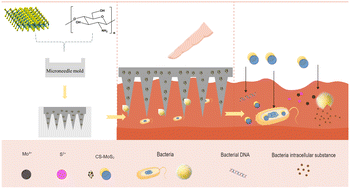Investigation of the antibacterial properties of hyaluronic acid microneedles based on chitosan and MoS2†
Abstract
Microneedle (MN) systems for painless transdermal drug delivery have been well developed over the past few years to overcome the problems of subcutaneous injections. Hyaluronic acid (HA) is a glycosaminoglycan that exists widely in living organisms, and chitosan (CS) is the only basic polysaccharide among natural polysaccharides, both of which have good biodegradability. Molybdenum sulfide (MoS2) is a typical layered transition metal disulfide with a two-dimensional structure and many unique physicochemical properties. However, its applicability in antimicrobial MNs is unknown. Therefore, in this paper, the antibacterial properties of the nanocomposites formed by MoS2 for MN preparation were investigated by combining the carbohydrate CS with antibacterial properties. The mechanical properties, irritation and blood compatibility of the prepared dissolving HA MN patches were investigated. Finally, the antibacterial properties of the composite MNs against Escherichia coli and Staphylococcus aureus were studied in vitro to evaluate the antibacterial properties of the developed antibacterial nanocomposite-loaded MNs. In addition, the results of the in vivo wound healing experiments showed that the dissolving antimicrobial MNs we prepared had a potential therapeutic effect on wound healing.

- This article is part of the themed collection: Microneedles


 Please wait while we load your content...
Please wait while we load your content...